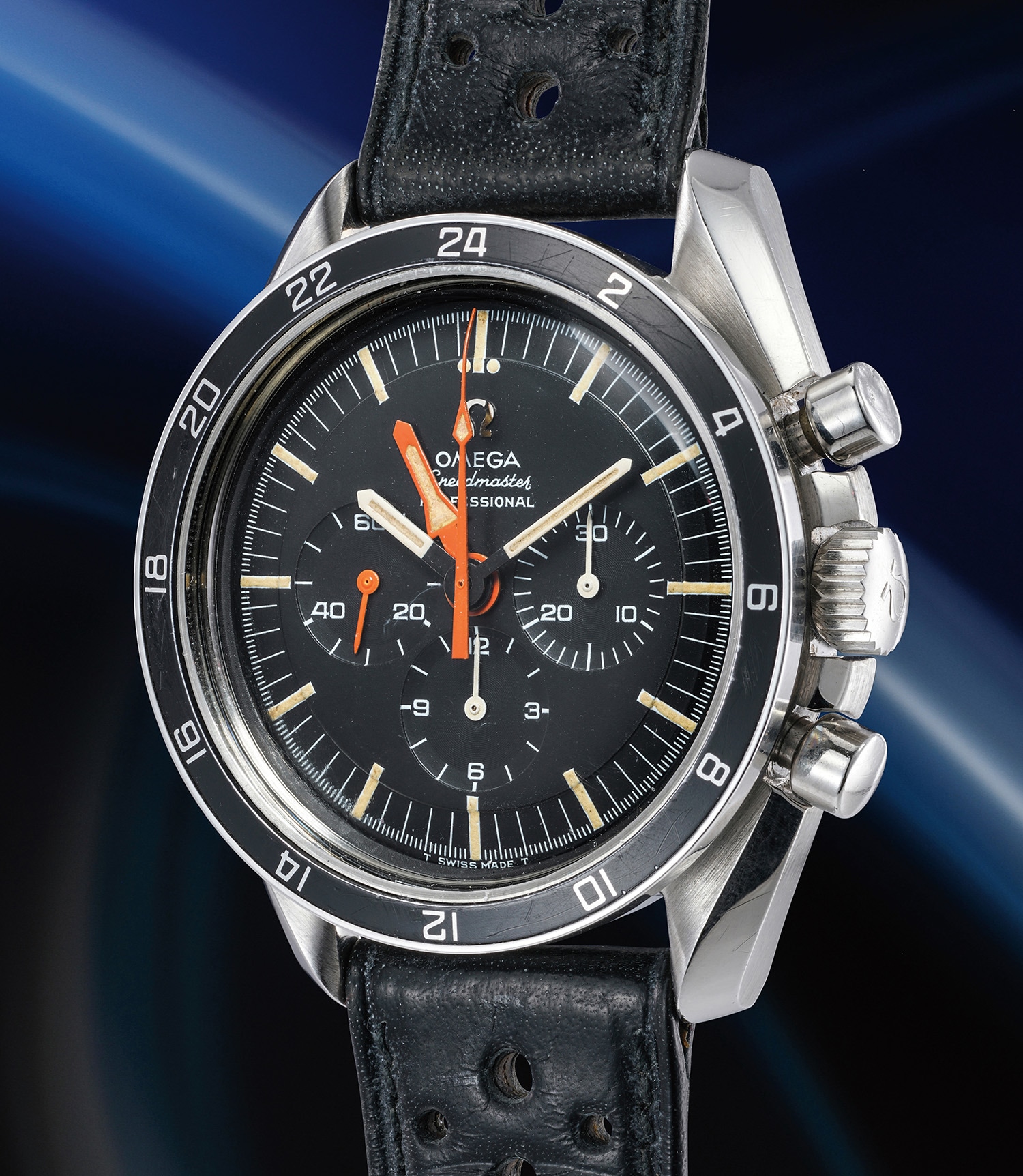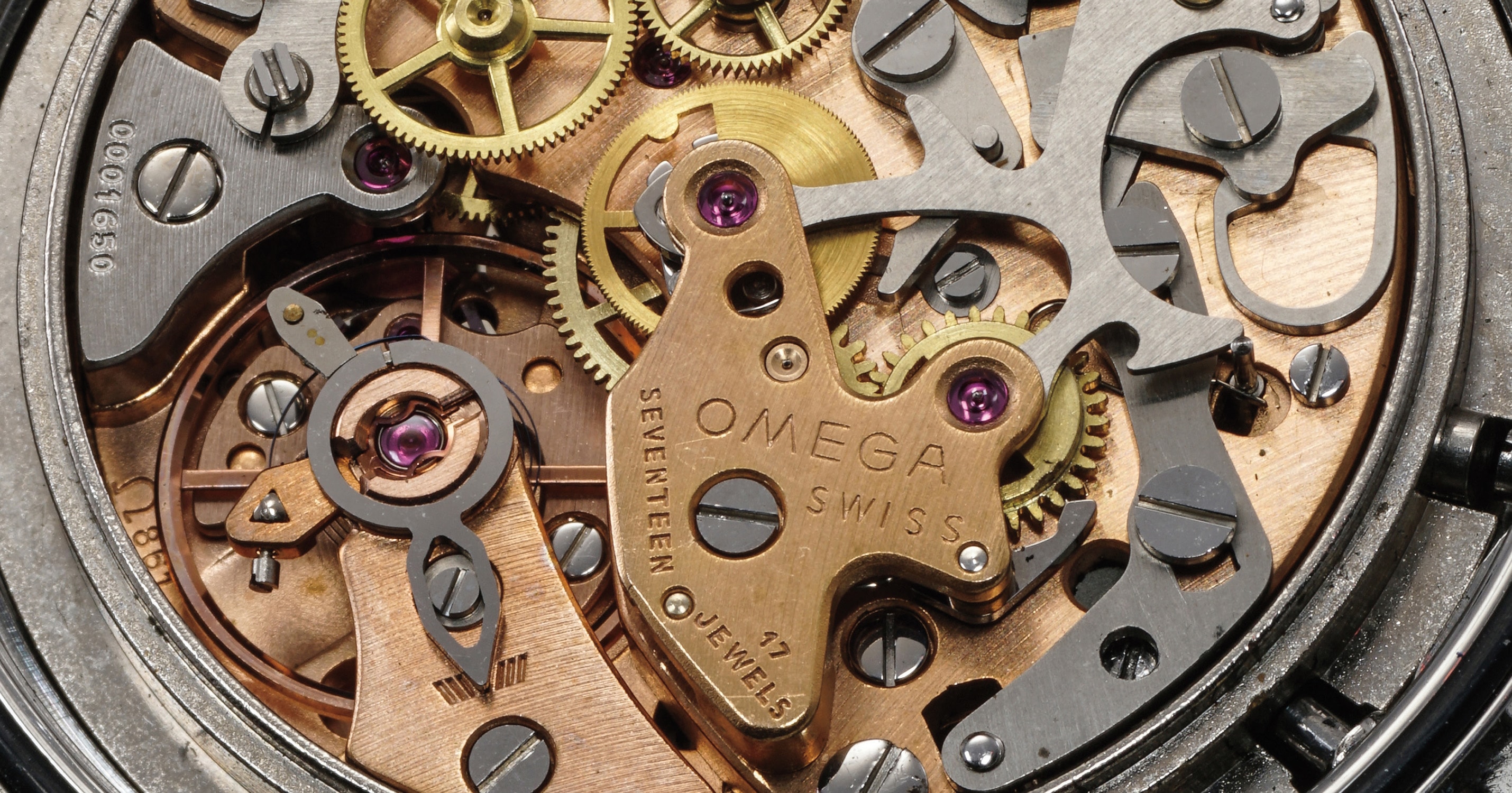







72
Omega
Ref. 145012-68SP
Speedmaster Professional, "Flightmaster Prototype"
A possibly unique, extremely unusual and superbly important stainless steel prototype chronograph wristwatch with additional 24-hour hand and bezel
- Estimate
- CHF60,000 - 120,000$60,100 - 120,000€61,800 - 124,000
CHF138,600
Lot Details
- Manufacturer
- Omega
- Year
- Circa 1968
- Reference No
- 145012-68SP
- Movement No
- 0001650
- Model Name
- Speedmaster Professional, "Flightmaster Prototype"
- Material
- Stainless steel
- Calibre
- Manual, cal. 861, 17 jewels
- Bracelet/Strap
- Leather
- Clasp/Buckle
- Stainless steel Omega Pin buckle
- Dimensions
- 42mm Diameter
- Signed
- Case, dial, movement and buckle signed
Specialist
Full-Cataloguing
Catalogue Essay
The present piece is without a doubt one of the most fascinating and important Omega finds of recent years, a true “first hand” representative of the ongoing R&D process that was happening at Omega in the 1960s, and the earliest known conceptualisation of what will eventually become the Omega Flightmaster.
While at first glance it would appear to be that of a standard Speedmaster 145012, the additional 24-hour hand (and matching bezel) as well as the case construction immediately categorise the piece as a mystery for the Omega connoisseur.
Thankfully, with the invaluable assistance of the Omega Archive, we were able to solve such a mystery and provide a detailed account of the genesis of the present timepiece.
During the 1960s, the collaboration between NASA and Omega was at its apex. In fact, a number of requests were made from NASA to Omega. Some of these requests were tested on “Alaska” pieces, some were employed in the Flightmaster (launched in 1969) and some other remained as either pure concepts or were made only in prototype pieces. The present watch is indeed a representative of the latter group. In fact, a 24-hour bezel (along with a 12-hour and a 5-minute ones as well) is, according to Omega, a documented NASA request.
As an added layer of intrigue, Omega has discovered that the mind behind the design of this piece is no other than Frederic Robert. Active since the 1950s in the watch industry (in fact the 1958 Aquastar, one of the very first diver watches, was deigned by Mr. Robert), in the 1960 he became an Omega consultant for professional and maritime watches. It is during this tenure that he designed the present prototype, of which the original sketch was gracefully provided to us by Omega. Mr. Robert’s hand is indeed the same which also designed the Flightmaster of which this watch represents a very early iteration. While maintaining the Speedmaster case and not being a dual-time piece (the central hand is purely a 24-hour hand), one of the principal design elements of the Flightmaster (the large central hand) is already present on this prototype. Mr. Robert will eventually modify the NASA-suggested 24-hour hand in a 12-hour additional timezone hand (thanks to the outer adjustable 12-hour ring) and will case the piece in a futuristic architecture miles away from the one of the Speedmaster. But it all started here.
To own a piece of Omega’s history of such remarkable importance, which shows how deeply the collaboration with NASA influenced the development of Omega watches at the time, is the dream of any Omega collector. When such an important piece is furthermore offered in such well preserved condition as the present one, it is undeniable that we are in the presence of an unmissable (and most likely unrepeatable) opportunity for the most serious Omega collectors.
We sincerely thank the Omega Museum for their updated scholarship and historical perspective in providing their own invaluable research and information on the present lot.
While at first glance it would appear to be that of a standard Speedmaster 145012, the additional 24-hour hand (and matching bezel) as well as the case construction immediately categorise the piece as a mystery for the Omega connoisseur.
Thankfully, with the invaluable assistance of the Omega Archive, we were able to solve such a mystery and provide a detailed account of the genesis of the present timepiece.
During the 1960s, the collaboration between NASA and Omega was at its apex. In fact, a number of requests were made from NASA to Omega. Some of these requests were tested on “Alaska” pieces, some were employed in the Flightmaster (launched in 1969) and some other remained as either pure concepts or were made only in prototype pieces. The present watch is indeed a representative of the latter group. In fact, a 24-hour bezel (along with a 12-hour and a 5-minute ones as well) is, according to Omega, a documented NASA request.
As an added layer of intrigue, Omega has discovered that the mind behind the design of this piece is no other than Frederic Robert. Active since the 1950s in the watch industry (in fact the 1958 Aquastar, one of the very first diver watches, was deigned by Mr. Robert), in the 1960 he became an Omega consultant for professional and maritime watches. It is during this tenure that he designed the present prototype, of which the original sketch was gracefully provided to us by Omega. Mr. Robert’s hand is indeed the same which also designed the Flightmaster of which this watch represents a very early iteration. While maintaining the Speedmaster case and not being a dual-time piece (the central hand is purely a 24-hour hand), one of the principal design elements of the Flightmaster (the large central hand) is already present on this prototype. Mr. Robert will eventually modify the NASA-suggested 24-hour hand in a 12-hour additional timezone hand (thanks to the outer adjustable 12-hour ring) and will case the piece in a futuristic architecture miles away from the one of the Speedmaster. But it all started here.
To own a piece of Omega’s history of such remarkable importance, which shows how deeply the collaboration with NASA influenced the development of Omega watches at the time, is the dream of any Omega collector. When such an important piece is furthermore offered in such well preserved condition as the present one, it is undeniable that we are in the presence of an unmissable (and most likely unrepeatable) opportunity for the most serious Omega collectors.
We sincerely thank the Omega Museum for their updated scholarship and historical perspective in providing their own invaluable research and information on the present lot.
Omega
Swiss | 1848Omega's rich history begins with its founder, Louis Brandt, who established the firm in 1848 in La Chaux de Fonds. In 1903, the company changed its name to Omega, becoming the only watch brand in history to have been named after one its own movements. A full-fledged manufacturer of highly accurate, affordable and reliable watches, its sterling reputation enabled them to be chosen as the first watch company to time the Olympic Games beginning in 1932. Its continued focus on precision and reliability ultimately led their Speedmaster chronograph wristwatch to be chosen by NASA in 1965 — the first watch worn on the moon.Key models sought-after by collectors include their first, oversized water-resistant chronograph — the reference 2077, early Speedmaster models such as the CK 2915 and 2998, military-issued versions of the Seamaster and oversized chronometer models such as those fitted with their prestigious caliber 30T2Rg.
Browse Maker